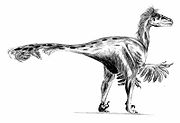
Prince Creek Formation
Encyclopedia
The Prince Creek Formation is a geological formation in Alaska
with strata from the early Maastrichtian
stage of the Upper Cretaceous, dating to between 70 and 69 million years ago. Dinosaur remains are among the fossils that have been recovered from the formation.
Alaska
Alaska is the largest state in the United States by area. It is situated in the northwest extremity of the North American continent, with Canada to the east, the Arctic Ocean to the north, and the Pacific Ocean to the west and south, with Russia further west across the Bering Strait...
with strata from the early Maastrichtian
Maastrichtian
The Maastrichtian is, in the ICS' geologic timescale, the latest age or upper stage of the Late Cretaceous epoch or Upper Cretaceous series, the Cretaceous period or system, and of the Mesozoic era or erathem. It spanned from 70.6 ± 0.6 Ma to 65.5 ± 0.3 Ma...
stage of the Upper Cretaceous, dating to between 70 and 69 million years ago. Dinosaur remains are among the fossils that have been recovered from the formation.
Theropods
| Theropods of the Prince Creek Formation | ||||||
|---|---|---|---|---|---|---|
| Genus | Species | Location | Stratigraphic position | Abundance | Notes | Images |
Dromaeosaurus Dromaeosaurus Dromaeosaurus was a genus of theropod dinosaur which lived during the Late Cretaceous period , sometime between 76.5 and 74.8 million years ago, in the western United States and Alberta, Canada. The name means 'running lizard'.... |
D. albertensis |
 |
||||
Saurornitholestes Saurornitholestes Saurornitholestes is a genus of carnivorous dromaeosaurid theropod dinosaur from the late Cretaceous of Alberta, Montana and New Mexico.... |
S. langstoni |
|||||
Troodon Troodon Troodon is a genus of relatively small, bird-like dinosaur from the Late Cretaceous period . Discovered in 1855, it was among the first dinosaurs found in North America... |
T. formosus |
|||||
Ornithischians
| Ornithischians of the Prince Creek Formation | ||||||
|---|---|---|---|---|---|---|
| Genus | Species | Location | Stratigraphic position | Abundance | Notes | Images |
Anchiceratops Anchiceratops Anchiceratops is a genus of chasmosaurine ceratopsid dinosaur from the Late Cretaceous Period of western North America. Like other ceratopsids, it was a quadrupedal herbivore with three horns on its face, a parrot-like beak, and a long frill extending from the back of its head. The two horns above... |
Indeterminate |
|||||
Brachyceratops Brachyceratops Brachyceratops is a dubious genus of ceratopsian dinosaur known only from partial juvenile specimens dating to the late Cretaceous Period of Montana, United States.... |
Indeterminate |
|||||
Pachyrhinosaurus Pachyrhinosaurus Pachyrhinosaurus is a genus of ceratopsid dinosaurs from the Late Cretaceous period of North America. The first examples were discovered by Charles M. Sternberg in Alberta, Canada, in 1946, and named in 1950. Over a dozen partial skulls and a large assortment of other fossils from various species... |
P. "perotorum" |
|||||
Parksosaurus Parksosaurus Parksosaurus was a genus of hypsilophodont ornithopod dinosaur from the early Maastrichtian-age Upper Cretaceous Horseshoe Canyon Formation of Alberta, Canada. It is based on most of a partially articulated skeleton and partial skull, showing it to have been a small, bipedal, herbivorous dinosaur... ? |
Indeterminate |
|||||
Thescelosaurus Thescelosaurus was a genus of small ornithopod dinosaur that appeared at the very end of the Late Cretaceous period in North America. It was a member of the last dinosaurian fauna before the Cretaceous-Tertiary extinction event around 65.5 million years ago... |
Indeterminate |
Teeth previously attributed to Thescelosaurus are more likely referable to Parksosaurus or a new genus. |
||||

